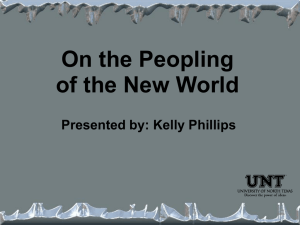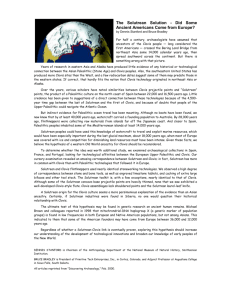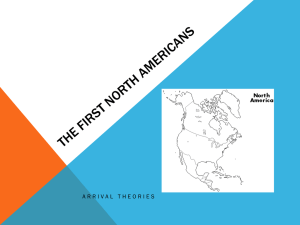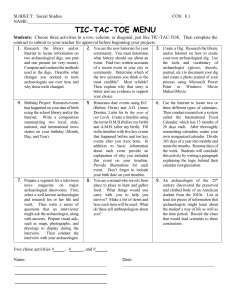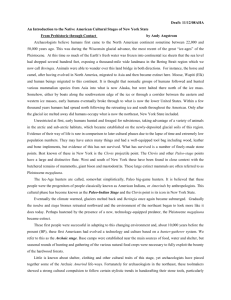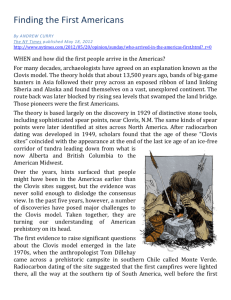The Dawn of Humans
advertisement
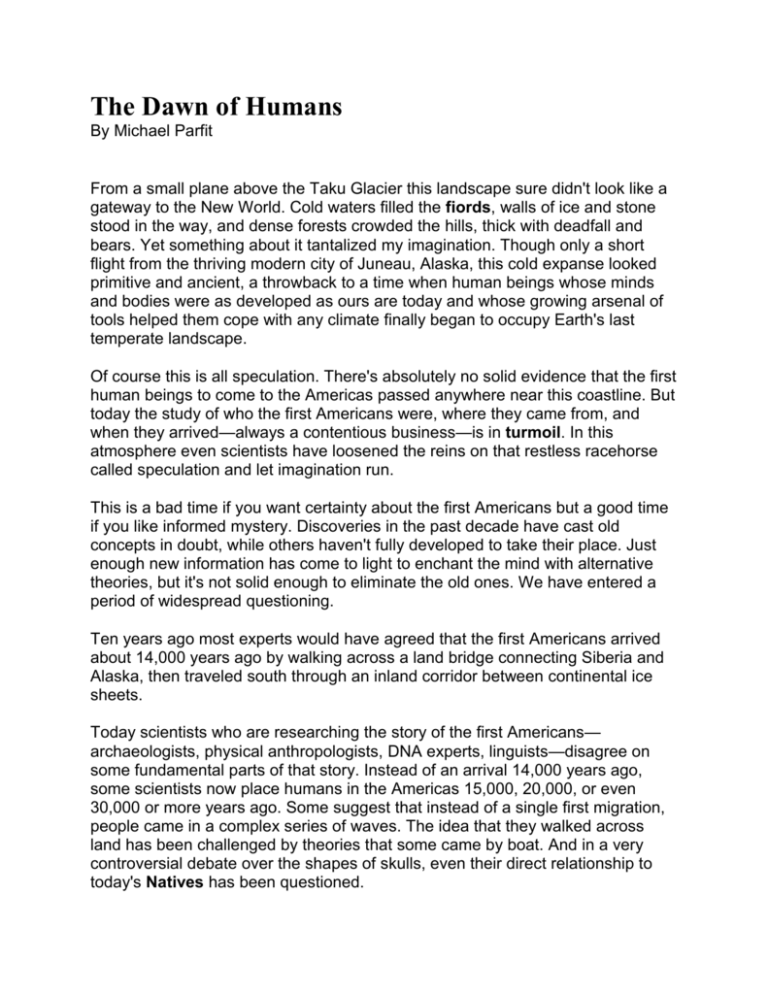
The Dawn of Humans By Michael Parfit From a small plane above the Taku Glacier this landscape sure didn't look like a gateway to the New World. Cold waters filled the fiords, walls of ice and stone stood in the way, and dense forests crowded the hills, thick with deadfall and bears. Yet something about it tantalized my imagination. Though only a short flight from the thriving modern city of Juneau, Alaska, this cold expanse looked primitive and ancient, a throwback to a time when human beings whose minds and bodies were as developed as ours are today and whose growing arsenal of tools helped them cope with any climate finally began to occupy Earth's last temperate landscape. Of course this is all speculation. There's absolutely no solid evidence that the first human beings to come to the Americas passed anywhere near this coastline. But today the study of who the first Americans were, where they came from, and when they arrived—always a contentious business—is in turmoil. In this atmosphere even scientists have loosened the reins on that restless racehorse called speculation and let imagination run. This is a bad time if you want certainty about the first Americans but a good time if you like informed mystery. Discoveries in the past decade have cast old concepts in doubt, while others haven't fully developed to take their place. Just enough new information has come to light to enchant the mind with alternative theories, but it's not solid enough to eliminate the old ones. We have entered a period of widespread questioning. Ten years ago most experts would have agreed that the first Americans arrived about 14,000 years ago by walking across a land bridge connecting Siberia and Alaska, then traveled south through an inland corridor between continental ice sheets. Today scientists who are researching the story of the first Americans— archaeologists, physical anthropologists, DNA experts, linguists—disagree on some fundamental parts of that story. Instead of an arrival 14,000 years ago, some scientists now place humans in the Americas 15,000, 20,000, or even 30,000 or more years ago. Some suggest that instead of a single first migration, people came in a complex series of waves. The idea that they walked across land has been challenged by theories that some came by boat. And in a very controversial debate over the shapes of skulls, even their direct relationship to today's Natives has been questioned. I flew my plane across Taku Glacier at the start of a journey that spanned the Americas, from Alaska to Tierra del Fuego. Many of the sites I visited were excavated with support from the National Geographic Society. On this trip I saw some of the evidence that has led to the present period of questioning. I listened both to the interpretations of archaeologists and to the traditional memories recorded in Native American oral histories. The science told me of the honest— and difficult—accumulation of facts that must underlie any real story of the past, and the oral histories reminded me of the fundamental need of all peoples to explain their beginnings. Madumda made new people from willow wands, taught them to hunt with a bow and arrow, how to make baskets, and how to eat, and then he went home to the north. But these people went bad too, so Madumda sent ice down to kill them all. — Pomo Creation Story In 1929 a teenager named Ridgely Whiteman wrote to the Smithsonian Institution about what he called warheads that he had been finding near Clovis, New Mexico. The spearpoints were elegantly chipped to sharpness on both edges and finished off with a groove, or flute, down the center of each side. Eventually such fluted points turned up in the oldest archaeological excavations elsewhere in North America. Stone can't be carbon-dated, but the dating of organic material found with the tools showed that the people who used them were in America no earlier than about 13,500 years ago. The story most archaeologists built on these ancient tools was of a people they nicknamed Clovis, who came into North America via Siberia, moved south through the ice-free corridor, then dispersed, their descendants occupying North and South America within a thousand years. Since their tools were often found with the bones of mammoths and other large creatures, scientists usually described the Clovis people as big-game hunters. For decades attempts to find proof of earlier people failed the rigorous tests of archaeological science. As late as 1996 a prominent archaeologist, Frederick Hadleigh West, could state in a major book that "Clovis is taken to be the basal, the founding, population for the Americas." But in the past decade that certainty has been dramatically shaken. The most straightforward challenge to the old story is the matter of time. The era in which the Clovis people lived is limited by a time barrier that stops about 13,500 years ago. Two things create that barrier: the dates of organic material found with the tools and geologic evidence that the ice-free corridor would not have been open much before then. But in 1997 a blue-ribbon panel of archaeologists visited a site in Chile called Monte Verde and agreed that people had lived there at least 14,500 years ago, about 1,000 years before the first sign of Clovis people in North America. Acceptance of the Monte Verde date not only broke the time barrier but focused new interest on other sites with early dates. One of these, Cactus Hill, south of Richmond, Virginia, has produced artifacts in layers of sand below Clovis tools. Dates there, which may go as far back as 18,000 years, are based on analysis of burned wood found near tools in what Joe McAvoy, chief archaeologist at the site, says are hearths. Dates at another site, the Meadowcroft Rockshelter near Pittsburgh, Pennsylvania, show that people may have lived in North America nearly 20,000 years ago. These early dates have been augmented by one DNA study that suggests, based on assumptions of a steady rate of DNA change, that people were in the Americas as early as 30,000 years ago and by at least one linguistics expert who argues that the large number of language families in North America proves that people were here well over 20,000 years ago. Disagreement on all these theories is vociferous. Most early dates are based on carbon dating, which is a fairly precise science, but often there's uncertainty about the degree to which ancient tools are physically associated with the plant or animal material nearby that can be dated. The organic material may be contaminated by another substance. At Meadowcroft, for instance, archaeologists who were skeptical of the early dates believed that the samples had been contaminated by groundwater seepage bringing in older carbon materials. (A recent study indicates that didn't happen, strengthening the Meadowcroft evidence.) Sometimes archaeologists disagree about the layering process that is also an indication of time. Some scientists are uncomfortable that at Cactus Hill only a few inches of sand are said to represent thousands of years of time. Arguments over these uncertainties can be public and fierce. You know it's a good day in archaeology," said Al Goodyear, "when you get up in the morning and there are 200 people and a TV crew looking in your pit." I was at the Topper site in southwestern South Carolina at a weekend meeting for archaeologists hosted by Goodyear. There were newspaper reporters and photographers, documentary filmmakers, and even a local TV station with a truck that had cranked an antenna on a pole into the tops of the trees in the hopes of broadcasting live. They were all here because Goodyear had uncovered flakes of stone that looked like those made by humans. The flakes were found in sand below material dating from about the time of Clovis. It was another apparent break in the time barrier. The presence of a TV crew indicated to some scientists that the story of the first Americans had become too popular and immediate for its own good. "Ideally everything should be hashed out by the experts first," said Stuart Fiedel, a consulting archaeologist and the author of a book about American prehistory. "But that hasn't been the pattern for a long time." Fiedel himself is part of that public pattern. He is the author of a scathing critique of the Monte Verde findings that appeared in a popular archaeology magazine. Fiedel attacked the evidence for Monte Verde's breaking the time barrier by claiming that the way some artifacts were recorded wasn't precise enough to support the conclusions. The critique was immediately attacked by some archaeologists and supported by others. One of those who had endorsed the Monte Verde findings was C. Vance Haynes, a geologist preeminent in the study of stratification at archaeological sites. But in response to the critique, Haynes wrote that he was backing away from his endorsement of the Monte Verde results. Though Fiedel's critique seemed to rebuild some of the broken time barrier, most archaeologists accept the Monte Verde date. To me the breakthroughs at Monte Verde, Cactus Hill, and Meadowcroft were exciting, and I wondered why some archaeologists seemed so cautious about dynamic new ideas. When I asked Haynes about that, he told a story of his own experience. In the late 1950s Haynes worked on a dig in Nevada called Tule Springs, which reportedly predated Clovis sites. There prehistoric animal bones were associated with apparent hearths dating back more than 28,000 years. What Haynes found instead was that the charcoal in the hearths wasn't charcoal at all but decaying vegetation on its way to becoming coal. The dates were right, but there had been no hearths—and no humans. "That was a real learning experience for me," Haynes said. "It makes you cautious. You begin to see how easy it is to misinterpret things." The time barrier is just one issue in the search for the first Americans. Another piece of the puzzle is how they got here. Skimming: 1. What main question is this article going to discuss? Prior Knowledge: 1. What do you know about this topic? 2. What do you believe about this topic? 3. What are 3 questions you have about this topic? Scanning: 1. 2. 3. 4. 5. Today, what is always “a contentious business?” Ten years ago, what would most experts have agreed on? Who is Madumda to the Pomo people? What is the method called that archeologists use to find out how old things are? Associate the locations with the dates of how long ago people lived there: a. Clovis b. Monte Verde c. Cactus Hill d. Meadowcroft 6. What does Stuart Fiedel think is “ideal.” 7. Does he think the evidence at Monte Verde is reliable? (Y or N) Comprehension: 1. Write down the ten bolded vocabulary items in the text. Using the information surrounding the words, try to write your own definition. 2. What is the “time barrier” that the author repeatedly refers to? 3. Explain what the author means by: “This is a bad time if you want certainty about the first Americans but a good time if you like informed mystery.” 4. What evidence is there to support the Monte Verde site? What evidence is there against it? 5. Why does Al Goodyear call the controversy “A good day in archeology?” Would Stuart Fiedel agree? 6. What lesson did C. Vance Haynes learn in Tule Springs? The Dawn of Humans Part II On the north edge of Alaska long slopes were white with cotton grass, and pools of water shimmered softly in their short flow from one night's ice to the next. I stood on top of a hump of rock called the Mesa, where ancient tools have been discovered near remnants of hearth fires. Mesa is near the route people might have followed if they had come across Alaska and taken the ice-free corridor to the south. Was this the way they had come? The Mesa site is in northern Alaska, but in the deeper context of geologic time it is in eastern Beringia. Beringia is the name of the chunk of land that, until about 11,000 years ago, connected Siberia and Alaska. Beringia has been called the Bering land bridge, but that phrase gives too narrow an image. Scientists have long believed that Beringia was the route the first immigrants took from Asia to North America. For years archaeologists have hoped to find a strong connection between early Alaska artifacts and those farther south, which might show the route used by the first Americans. Tools with characteristic Clovis flutes have been found in Alaska, but none has been dated. And many early Alaska sites contain microblades, which were probably embedded in the sides of bits of antler or bone to make tools like knives. Microblades are seldom found at Clovis sites. To explain this apparent lack of connection, some archaeologists say that it's entirely possible that the whole population of the Americas could have been started by one small group of people—as few as a couple of dozen—who dashed desperately through the ice-free corridor. They would have left no trace in their wake because of the speed of their movement, and they could have developed the distinctive Clovis tools later to kill the big game they found when they reached the Great Plains. Bureau of Land Management archaeologist Michael Kunz, project director at Mesa, believes that the tools he has found there are a link between Alaska and the south because of shapes and flaking techniques that look similar to some tools from the Great Plains. But other archaeologists disagree. Some argue that the Mesa site represents people of later years moving north instead of south, and yet others think that the tools were left behind by occasional visitors from other parts of Alaska. These varied opinions, all based on the differing ways that individuals analyze the same collection of shaped rocks, reminded me of something a Canadian archaeologist had told me. "We are a discipline, not an exact science," she said. "We shouldn't pretend we are. Everything is subject to interpretation." As I traveled south in hot pursuit of the phantoms of early America, those words would echo. Although parts of archaeology are based on hard science, such as carbon dating, archaeological fact is never more than consensus based on relatively few samples. Today, in spite of increasingly rigorous research, consensus on some critical issues appears to be far off. "It's chaos," more than one archaeologist told me. But it is a fertile kind of chaos, with new ideas brewing everywhere in the mix. The Dawn of Humans Part III Lost twice in a maze of trees, I finally heard the roar of a generator and followed the sound to a cave. It was a little hole in a stone cliff surrounded by tarp shelters, hoses, wires, and buckets of mud, but the scientists excavating there think that its contents will help break what might be called the ice barrier. The cave is on Prince of Wales Island in southeast Alaska. Until recently this area was thought to have been completely buried by glaciers during the last ice age, forming a barrier to migration. No more. "Plants and animals lived in this area all along," said Timothy Heaton, a paleontologist, as we crouched in the cave. "Conditions would have been very compatible with human habitation." James Dixon, an archaeologist working with Heaton, and others suggest that in addition to the humans walking across Beringia, some made their way into North America from Asia by boat along the edges of land and ice. "There had to be pockets of ice-free areas," Dixon said, standing in a trench outside the cave. "There's no reason people couldn't have come along the coast, skirting the glaciers just the way recreational kayakers do today." A few years ago Heaton and colleague Fred Grady found parts of a human skeleton in the cave. The bones were dated to about 10,500 years ago, and other tests revealed that the person had been raised almost entirely on seafood. Though not as old as Clovis, the bones showed that a maritime culture was well under way. "By then people were already living up and down the coast," Dixon said. "They had watercraft and engaged in trade." Evidence that early Americans used boats also comes from the Channel Islands off California. A few human bones unearthed on Santa Rosa Island were recently dated to about 13,000 years ago. They're among the oldest human remains on the continent. Though they, like the bones in Alaska, are a bit younger than the earliest Clovis tools, they also prove that sometime after early Americans got here, they knew how to get around on the water. But showing that people actually got here by boat is much harder. Sea levels at the end of the last ice age were about 300 feet lower than today, so coastal camps would now be deep underwater. In 1998 two Canadian scientists seeking such camps off the Queen Charlotte Islands dredged up a stone tool. The tool, a volcanic rock flaked into what may have been a knife, came from 175 feet down, near where the shoreline would have been 11,500 years ago. When I visited the scientists on a research vessel the following year, they discovered a pine tree stump in place at 475 feet, about the same depth as an even older shoreline, proving that sea levels were low and that people could have been there. But they found no more tools. And that one tool, which could have fallen out of a kayak a few thousand years ago, doesn't prove an early occupation. So the evidence on the west coast remains exciting but inconclusive. The Dawn of Humans Part IV On the east coast there's another tantalizing—but untested—theory of a route that people could have taken to the Americas, with similarly thin but intriguing evidence. The idea, suggested several times in the past century, has recently been revived by Dennis Stanford of the Smithsonian and archaeologist Bruce Bradley. The idea throws even the assumption of Asian origin into question: It says the Clovis people may have come not across Beringia but across the Atlantic. Artifacts developed by a southwestern European culture called Solutrean are sometimes strikingly similar to Clovis tools, Stanford says. To him there's a stronger connection from America to the European tools, which date from about 20,000 years ago, than to tools of a similar age across the Pacific. "The Asian projectiles are narrow and thick," he said. "Clovis and Solutrean are wider, flatter, thinner. Not everything in Solutrean is found in Clovis, but everything in Clovis is found in Solutrean." The two archaeologists suggest that 18,000 to 24,000 years ago Solutrean people may have used watercraft similar to Eskimo skin boats to navigate all the way to North America. Does this imply that the first Americans might have been blue-eyed white people, as racist groups sometimes suggest? No. Theories like this, archaeologists insist, offer no racial information at all. What we think of as racial characteristics, like skin color, can change rapidly as humans mingle and move. "It's not racial," says Stanford. "It's a matter of technologies. We have no idea what race they were." Solutrean tools faded away from Europe about 19,000 years ago because the people either left or changed their technology. But Stanford thinks that sites like Cactus Hill, whose dates appear to go almost that far back, may contain Solutrean remains. "We're just getting started on this," Stanford said. "We're going to have a lot of bright graduate students trying to prove we're wrong. And even if we're wrong, we'll know a lot more about both Clovis and Solutrean, and that's worth it. I've been wrong before, and it's sure gotten people's attention." Some of the archaeologists I've asked about this theory scoff at it. Loudly. To Lawrence Guy Straus, an expert on the Solutrean culture, the distance from Spain to America and the 5,000-year time difference between the Solutrean disappearance and the generally accepted dates for Clovis make the theory impossible. "Sorry," he said. He added that there's no evidence that the Solutrean culture included navigation, deep-sea fishing, or marine-mammal hunting. And Straus had no sympathy for Stanford's idea of tool similarities. "One of the great failings of archaeology," he told me, "is a continuous falling back on the notion that if a couple of things resemble one another, they have to have the same source. But these similarities appear and reappear time and again in different places." Michael Collins, an archaeologist working at the Gault site in Texas, a prime Clovis site, was more intrigued. To Collins the many similarities with Solutrean tools shouldn't be ignored. "There's enough smoke there that someone had better start looking for the fire," he said. The Dawn of Humans Part V When and how people got here are only two parts of the puzzle. A third piece, which is just as uncertain in today's climate of questioning, is who the first Americans were. Some of the evidence is based on skulls. In Rio de Janeiro I went to a museum housed in a former palace to see a famous skull called Luzia. It was stored in a cardboard box. When the skull was brought out, it looked small as a child's face. Luzia was found about 25 years ago near Belo Horizonte, north of Rio, in a site dated at around 13,500 years. Recently there was a dramatic development: A new analysis of the shape of the skull indicated that she didn't look much like an American Native. Just who she did look like was another matter. The new research focused attention on the views of Brazilian scientist Walter Neves, who claims that her skull shape is more like those of people from Africa or the South Pacific than like modern Indians. He suggests that she might have descended from Asians who may also be ancestors of the original Australians. The problem with early skulls, though, is that they have led to very loud conclusions based on very slender evidence. In the United States one counterpart to Luzia is a 9,500-year-old skeleton known as Kennewick Man, which was found in Washington State in 1996. The skeleton has been locked away from most research during a legal fight that developed because five Native tribes believe they have the right to claim and bury Kennewick Man, while a group of scientists think the ancient bones should be studied. Early newspaper reports suggested the skull looked like that of a white man, because archaeologist Jim Chatters used the term "Caucasoid"—a technical description of skull shape that indicates a difference from Mongoloid but doesn't mean Caucasian. All Chatters meant in his initial reports was that the skull, in a modern context, would not have been identified as Native. But what the skull means to prehistory is still unknown. For scientists, attributing race to an ancient skull is misguided, in part because race isn't a scientific way to categorize human beings, in part because the races we identify today probably didn't exist 9,500 years ago. After initial reports attached a race to Kennewick Man, Chatters tried hard to quell the flood of racial speculation. "Nobody's talking about white here," he said. The classification of humans by skull type has an ugly history, including efforts by the eugenics movement to reinforce racial stereotypes with studies based on skull measurements. Because of this and because skull shapes can be influenced by things like diet, many archaeologists hesitate to draw conclusions. But the bones of Luzia, Kennewick Man, and a few other ancient skeletons are part of a very small amount of evidence about who early Americans actually were, so physical anthropologists are trying to learn what they can from them. "When you study these early skeletons," said Doug Owsley, a physical anthropologist from the Smithsonian Institution, "they do not have as wide a facial breadth as modern Native Americans and are not as heavily built in the face, and they have a longer, narrower cranial vault." This doesn't necessarily tell you who came from where. "One skull doesn't mean anything," one archaeologist told me. "Look at all the different shapes of the heads of spectators in one football stadium." Such skepticism about skulls is in part based on a study by Franz Boas, one of the giants of the discipline, who reported in 1911 that the children of immigrants in New York City had significantly different head shapes from their parents. To get around these concerns, Owsley and Richard Jantz, another physical anthropologist, are collecting abundant statistics. If large numbers of skeletal measurements show that certain groups from one place differ consistently from groups that came from somewhere else, then it may eventually be possible to be more confident about the origin of Kennewick Man. But that time isn't yet here. Owsley will only offer hints. To him the early skulls tend to look a little like the ancestors of modern Polynesians or of the Ainu of Japan, who are a remnant of a people who once roamed widely in coastal Asia and had a maritime culture. Both of those sources would fit well with theories of arrival across the land bridge or by boat along the Pacific Rim. But because the bones are so varied, the story they tell Owsley so far isn't about a single invasion but of a gradual accumulation of peoples. "This would be consistent with multiple waves happening over time," he said. "And you cannot at this time rule out people coming across the Atlantic. It would be a rich, complicated story." The Dawn of Humans Part VI If the study of stones and bones often seems subjective, the study of DNA looks far more like hard science. After all, you can convict criminals on the basis of DNA, so why can't you track the first Americans? So far DNA analysis hasn't brought the clear-cut answers everyone is hoping for. DNA studies that follow characteristic markers through mothers' genes have supported in very general terms the idea that North Americans arrived from Asia. These markers don't give simple answers, however. For instance, one of the markers in Native American genes shows up in modern genes from Europe and Central Asia, but not from Siberia, indicating either that people who carried it died out in Siberia after the migration to America or that Stanford's idea of a move directly from Europe might have some genetic backing. DNA evidence can also conflict with the stories told by skulls. Though early skulls like Kennewick Man show some similarities to the Ainu, studies conducted in Japan have turned up almost no DNA links with early Americans. Most DNA data, in fact, lead in a different direction. "From the point of view of mitochondrial DNA," said David Glenn Smith, an anthropologist at the University of California at Davis, "the best bet for the origin is the Lake Baikal area of Russia." I talked to Smith in a small office next to the lab where he analyzes DNA samples. On his wall was a map of the United States with gold stars marking places where some of the 40 oldest skeletons have been found. He has been collecting samples of some of the bones and is conducting a major study of their DNA. "We want to find out if there's any evidence that early people look different from later people," Smith said. "If their skulls differ, there's cause to ask if they also look genetically different." So far, though he is busy asking the question, he has released no formal answers. All this uncertainty obscures another part of the story of the first Americans: How wonderful it is to have even a tiny glimpse of those ancient lives. On a beach in Tierra del Fuego stood a small hut made of the branches of Antarctic beech trees. It is a copy of the huts once used by Yámana Indians, who lived here when the first European explorers came but are now almost gone. A cold wind blew up from Cape Horn and rattled the dry leaves on the branches of the hut. I climbed into the hut and tried to imagine the past. This was the end of the Earth—one of the last places people came to live. The record so far shows they arrived at this southern tip of Tierra del Fuego only about 8,300 years ago. The stories here are just as confusing as elsewhere in the Americas. When explorers from Europe arrived, four separate peoples inhabited this relatively small landscape. Each group looked different from the others, and they spoke two different languages. The Argentinian archaeologist who brought me here, José Luis Lanata, described the question of how all these different groups got here as "a puzzle of many combinations." You can apply that phrase to the whole story of the first Americans. What will it take to solve the puzzle? Today the study of early Americans stands at a moment of scientific turmoil: Established theories are shaken to their roots, and new ideas are stacked all over the place—ideas about boats from Asia, boats from Spain, arrival 30,000 years ago, arrival 13,500 years ago. Realistic scientists don't see much resolution soon. Speculation is abundant, but the basic raw material of science—real, conclusive evidence itself—is very hard to find. "We need a series of pre-Clovis sites," one archaeologist told me. "We need four or five in a row. Maybe in the next century or two we'll get some." José Luis Lanata agreed it's going to be a long time before the puzzle is solved. "The debate about the first Americans," Lanata concluded, "could break the nerves of the most patient man in the world."


